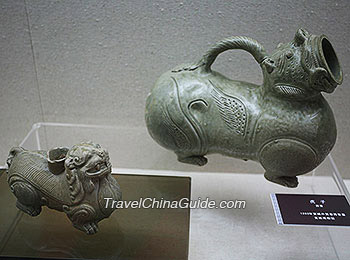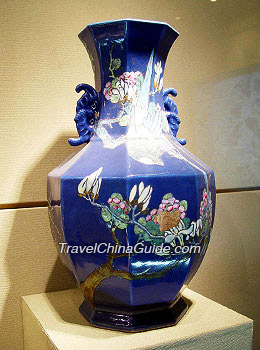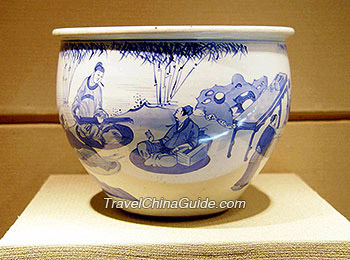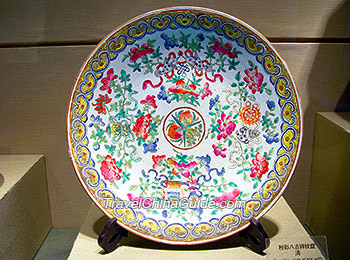Chinese Porcelain
 |
| Celadon Porcelain, Western Jin Dynasty |
Porcelain, also called 'fine china', featuring its delicate texture, pleasing color, and refined sculpture, has been one of the earliest artworks introduced to the western world through the Silk Road. The earliest one was found made of Kaolin in the Shang Dynasty (17th - 11th century BC), and possessed the common aspects of the smoothness and impervious quality of hard enamel, though pottery wares were more widely used among most of the ordinary people. Anyway it was the beginning, which afterwards in the succeeding dynasties and due to its durability and luster, rapidly became a necessity of daily life, especially in the middle and upper classes. They were made in the form of all kinds of items, such as bowls, cups, tea sets, vases, jewel cases, incense burners, musical instruments and boxes for stationary and chess, as well as pillows for traditional doctors to use to feel one's pulse.
 |
| Cloisonne, Ming Dynasty |
The development of porcelain in the Han Dynasty (206 BC - 220) began to accelerate and before long the artworks were introduced westward. Celadon (like the color of jade) and black porcelain wares were the dominant types at that time. Styles had formed and differed based on regions by then. The Yue Kiln in Zhejiang Province, which has enjoyed a good reputation for over 2,000 years up to now, produced delicate and hard celadon porcelain; while the De Kiln became the earliest kiln that baked black porcelain.
During the Tang Dynasty (618 - 907), a large number of porcelain wares were in daily use having been substituted for the ones made of gold, silver, jade and other materials. With export, Chinese patterns on these wares also took on more exotic appeal. The Yue and De kiln of Zhejiang Province had features that were the most popular ones, and another one, Xing kiln in Hebei Province was greatly prized for its white porcelain as 'white like snow'. Kilns baking porcelain for the royalty sprang up producing elegant and dainty works.
 |
| Blue and White Porcelain, Yuan Dynasty |
Stepping into the Song Dynasty (960 - 1279), a variety of genres of porcelain appeared and it became a fashion that people showed great interest in purchasing and collecting certain wares suitable to their tastes. Ru, Ding, Ge, Jun and the official kilns had been the representatives of that age. Official kilns advocated concise patterns of decoration; Ru kiln in Hebei Province added treasured agate into glaze so that the color and texture appeared to be uniquely daintily creamy and could be compared with jade. Henan Province had two famous kilns named Jun and Ding kilns. Since the reign of Emperor Huizong who liked art appreciation, porcelain of Jun kiln was kept exclusively for the royal family and common people had no right to collect it no matter how much money they possessed. Since the artisans made their porcelain wares separately, there was no repetition among decorative patterns and colors. Thus this made each product more precious in its own right. Ding kiln boasted its white porcelain which has a texture as delicate as that of ivory with an adornment of black and purple glaze. Distinctive from the other four kilns which stressed color, this one was quite good at engraving and printing flower patterns. While the Ge Kiln produced articles with various grains and produced an amount of artworks greater than those of the other four.
Well developed in the Yuan Dynasty (1271 - 1368), the blue and white porcelain (Qinghua Ci), in the main stream of porcelain, was the stylish artistic ware in the Ming Dynasty and Qing Dynasty and promoted this period to be the most prolific in the field of feudal art. First it painted on the basic body with brush natural cobalt which would be turned blue after being in the forge. Set off by the white glaze and covered by the other level of clear glaze, the blue flowers and other patterns showed their comely charm and were widely welcomed among both refined and popular tastes. With the diversity of cobalt, theme, and style of painting, the blue and white porcelains differed constantly, each being unique.
 |
| Famille-Rose Porcelain, Qing Dynasty |
As we know, the featureslie in texture of basic body, color of glaze, decorative pattern, shape and style, while porcelain at that time had sublimed to be at the most elegant. The famille-rose porcelain was another highlight that appeared during the reign of Emperor Kangxi (1653 - 1722). The finished article appears more stereoscopic, colorful, gentle and clean. Nearly all the refined colored pigments were utilized like ancient purple, magenta, ochre, emerald, and so on.
Through the development of 4,000 years, now it is still a brilliant art that attracts many people's interest. The Porcelain Capital, Jingdezhen in Jiangxi Province which has been praised for thousands of years, will be certain to satisfy your esthetic appetite.![]() Read more: Jingdezhen Porcelain
Read more: Jingdezhen Porcelain